Dear Dani, Grace and Jude,
Note: This page is advice for Grace, Jude and John. For any other reader, it’s information only. No therapeutic relationship is formed – read this.
If Grace or Jude get type 1 diabetes, the school holidays will be a significant glucose control challenge. Just like two weeks of annual leave is for me.
Sleeping patterns go out of the window with progressively later nights and wake times.
The snack cupboard is always in business.
Activity levels drop as TV watching goes through the roof.
Regular exercise sessions stop.
Insulin requirements increase, and excess fat is quickly gained.
This drastic change in sleeping, eating, and moving requires one of two things to keep glucose levels under control:
- A tremendous increase in insulin to keep up.
- Creating conditions of consistency in sleeping, eating and moving.
I will walk you through the second option, as increasing insulin for the holidays will only lead to fat accumulation that will make glucose control much harder in the long term. Remember how I talked about keeping units per kg under control?
Dani, you employ the 80:20 rule. You prioritise the 20% of things that give 80% of the benefit. I go all-in for the final 20% at the cost of a lot of energy with diminishing returns – but I love it!
Before reading on, we must ask ourselves a fundamental question.
Do we want Grace and Jude to do all things “normal” kids do?
If we do, then we must accept everything being “normal” has to offer in today’s environment:
- A 50% chance of being overweight or obese and becoming insulin resistant from age 16 due to:
- Eating lots of processed food.
- Eating only two portions of fruit and veg per day.
- Only doing 30 minutes of moderate activity per day.
- Sleeping two hours less than recommended.
- High risk of poor mental health due to:
- More than two hours per day of social media usage.
- Only 30 minutes of moderate activity per day.
- Limited access to daily natural light.
- Constantly being in sleep debt.
Suppose we want to guarantee their physical and mental health?
In that case, we must create conditions for an abnormal lifestyle that is more in tune with the last three million years of human evolution.
More normal or more natural?
If more normal, stop reading here.
If more natural, crack on.
Here are the 80:20 and kitchen sink daily schedules for the school holidays to keep glucose under control.
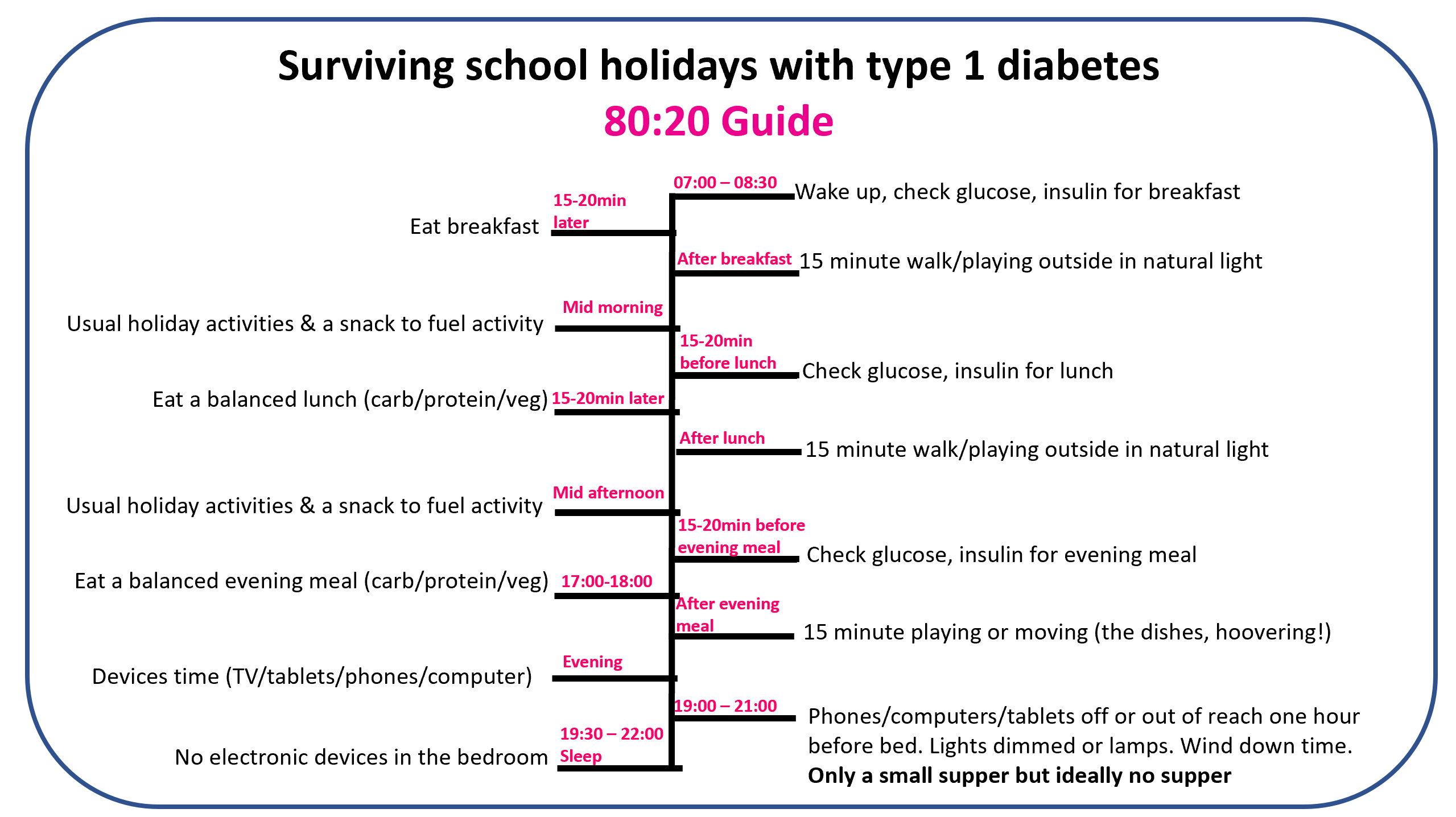
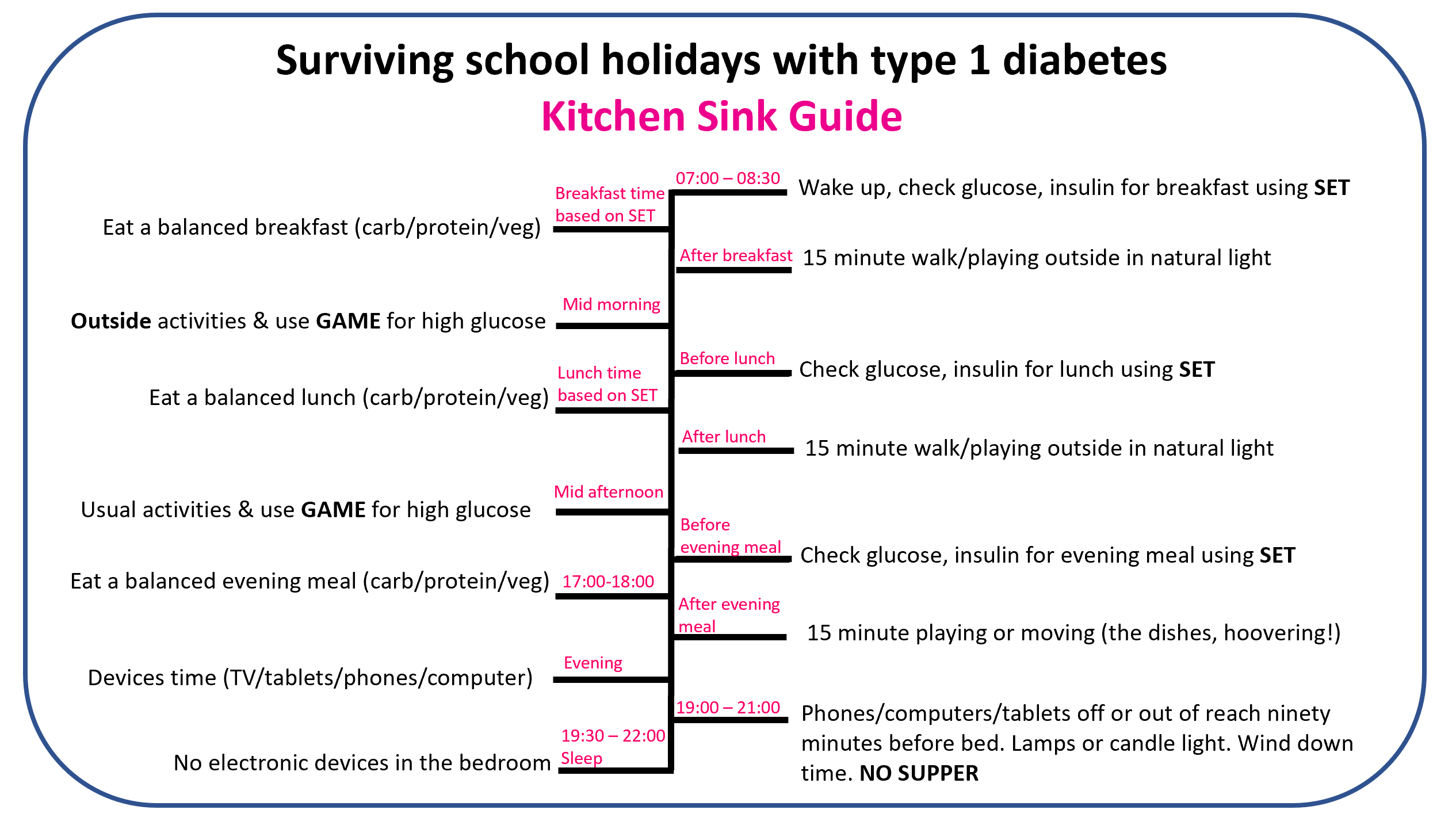
If you are curious as to why I have suggested these daily routines, read on.
Sleeping routine
Surprised I am discussing sleep first?
For me, sleep is the most critical aspect when it comes to routine.
The human body runs on a set of biological clocks called the circadian rhythm.
When these biological clocks are in sync, we wake up refreshed, have great energy throughout the day, and stay sensitive to insulin.
When the clocks are out of whack, we feel tired, grumpy, energy levels are low, and insulin resistance kicks in.
In my book, keeping your clocks chiming in time is the key to a happy and healthy experience!
Before I tell you how to do this, a little lesson in sleep cycles.
When asleep, the body runs through different stages of sleep in ninety-minute cycles.
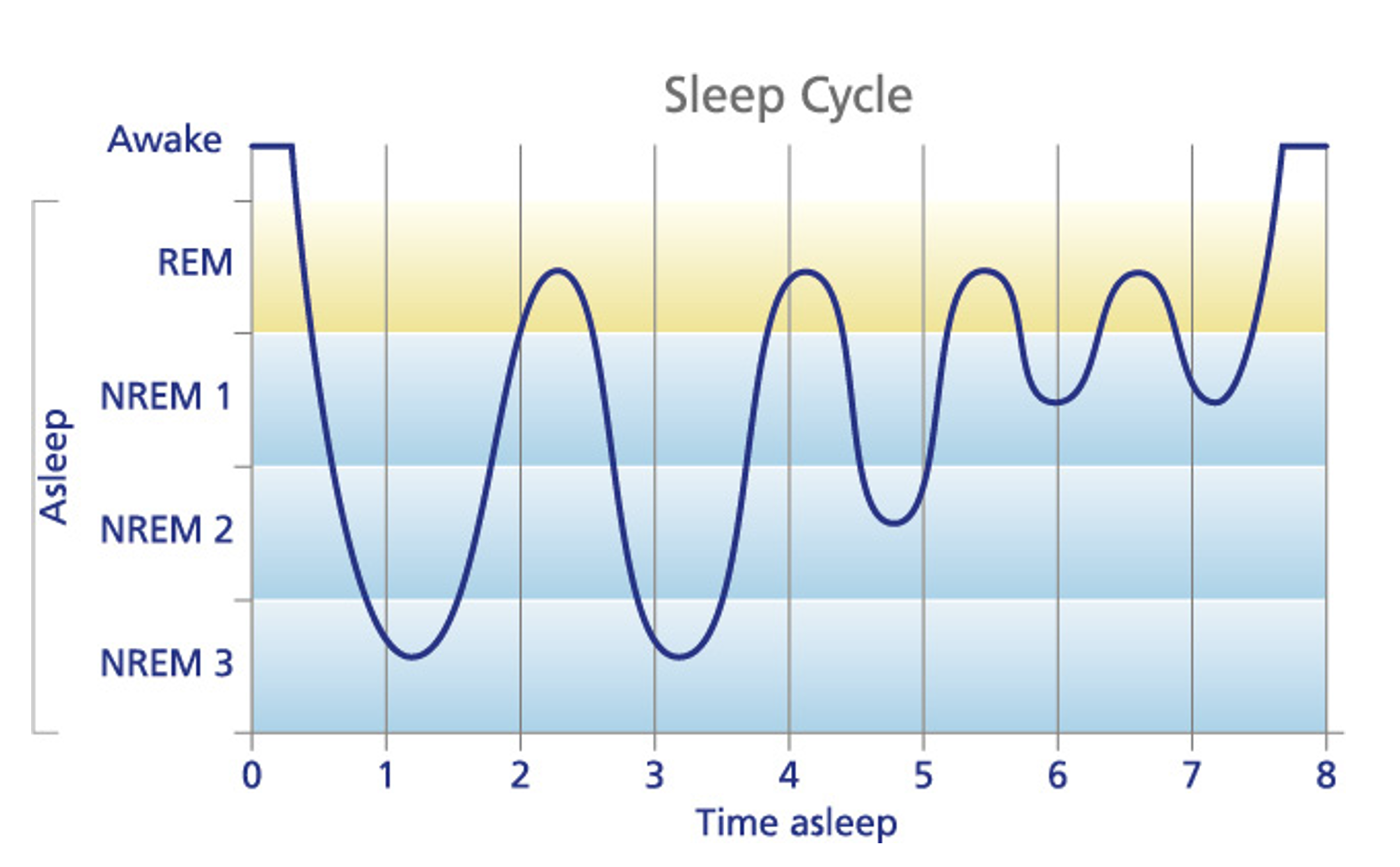
Each stage of sleep performs various functions of physical and mental restoration. A bit like a daily MOT for the car. Matthew Walker’s book “Why we sleep” is the best I have read to gain a deeper understanding.
For this article, let’s keep it simple.
- REM – Rapid eye movement sleep where the brain is restored, and new brain connections are made.
- NREM – Non-rapid eye movement where the body is repaired and insulin sensitivity is maintained.
Physical restoration occurs in the first 4-5 hours of sleep (NREM 2-3). One night of only four hours sleep made muscles cells more resistant to insulin by 21% in a sleep deprivation study performed on seven people with type 1 diabetes.
Mental repair in the last 4-5 hours of sleep (NREM 1 & REM). This is the time where learning is transferred to long-term memory and connections to existing knowledge are made. Therefore, cutting sleep short to revise for exams is fool’s gold.
Adults need five sleep cycles a night, 7 ½ hrs sleep, and children 6-8 cycles, 9-12 hrs sleep.
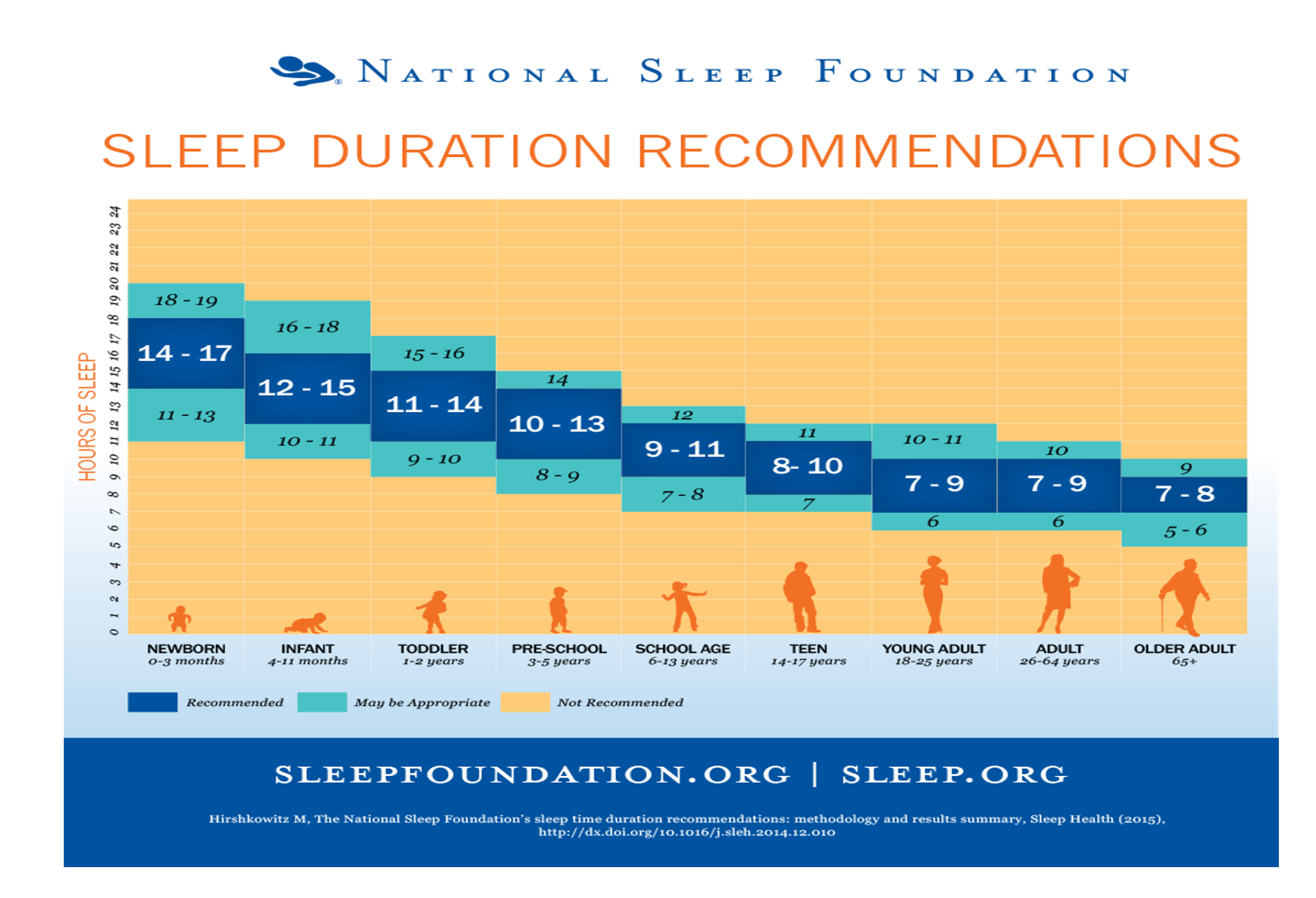
Getting enough hours is particularly important, but so is sleep timing.
Human evolution has programmed the body to optimise physical restoration in the hours of 21:00 to 03:00 and mental rehabilitation 03:00 – 08:00.
This dovetails nicely with school days but can go out of the window in school holidays and the weekend due to Netflix, X-box, Play station, social media, and dare I say it – sloppy parenting!
What is the main thing that disrupts our sleep?
Light and its impact on our sleep-inducing brain hormones!
The primary hormone in the brain that tells us to go to sleep is melatonin. This graph shows how it is supposed to increase and decrease across the day to facilitate sleep and alertness at the correct times.
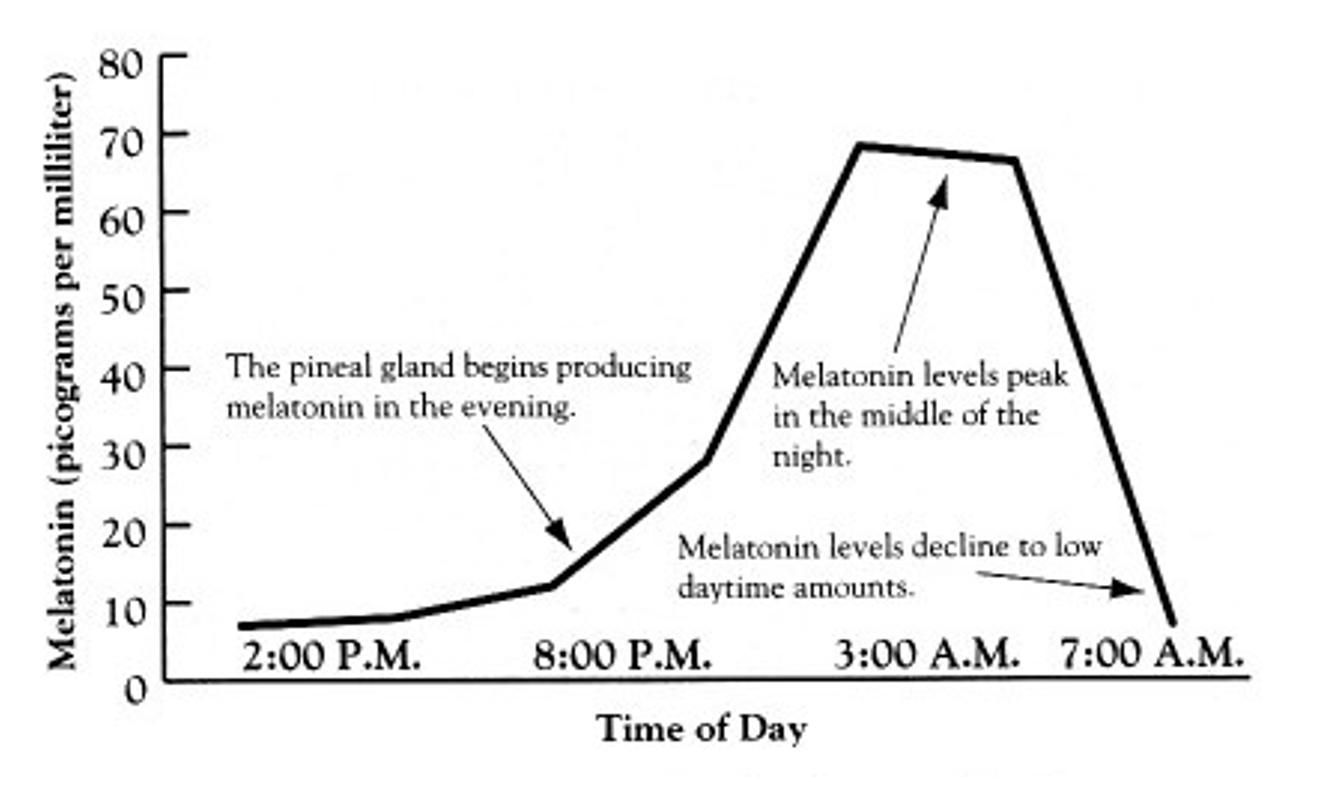
Why do you not start feeling sleepy at 20:00?
Look no further than the phone, tablet, computer games, bright light in the TV room and worst of all electronic devices in the bedroom!
The graph shows how bright light from these devices stops you from feeling sleepy.
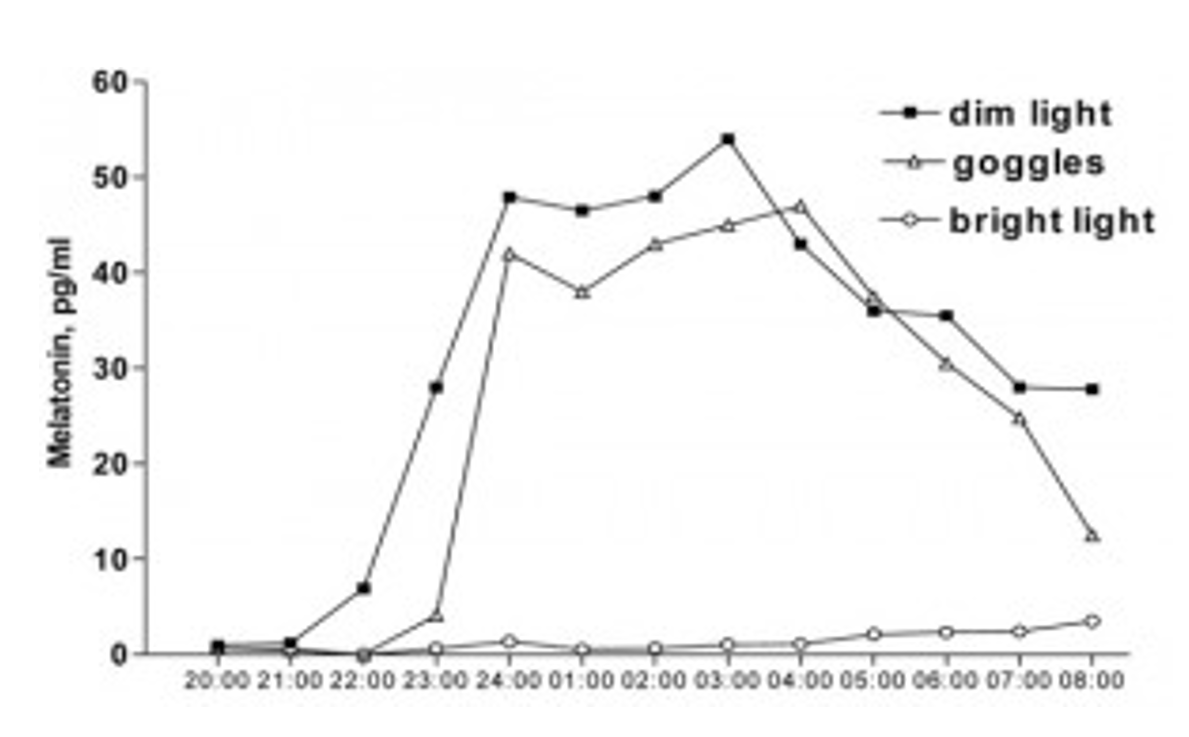
The solution is simple but not popular. Get off your devices at least an hour before bed. This means both of us, Dani. Monkey see monkey do remember.
Grace and Jude idolise us and look at our behaviour as the perfect thing to do. If we are fixated on our phones all day and all night, they will follow our lead.
Is all bright light terrible?
Not at all. The body needs bright light in the morning to wake up.
Bright light in the morning drops melatonin, gets the wake-up hormones firing, and we start to feel great! It is nature’s double espresso.
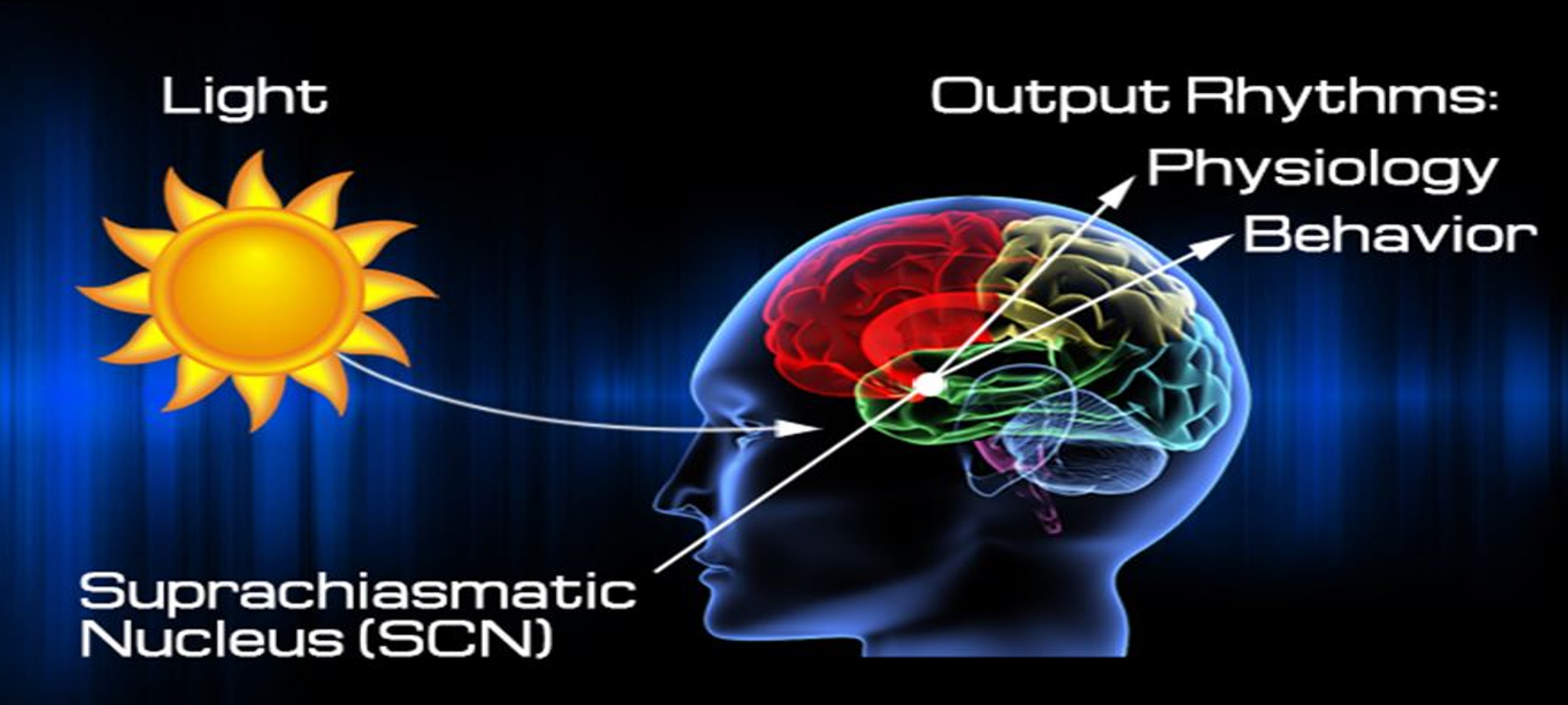
So, X-box and iPhone first thing on waking?
Hardly!
Let me introduce you to Lux. Lux is the measure of the intensity of light. Human beings have evolved with natural light and need a huge contrast in Lux across the day for the perfect chiming of biological clocks.
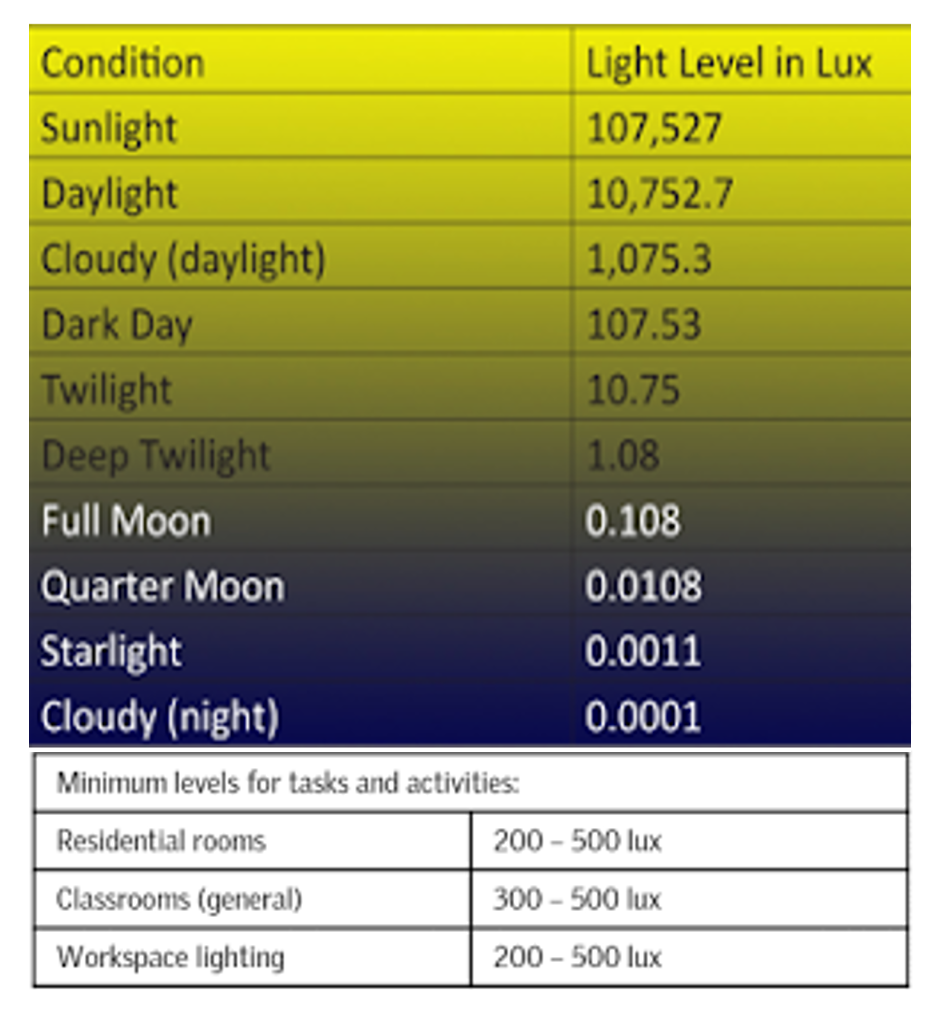
For optimal circadian rhythm, we should:
- Expose our eyes to daylight first thing to get 10,000+ Lux, for at least 15-30 minutes.
- We should be out in natural light periodically throughout the day.
- Before bed, we should be seeing no more than 100 Lux (lamplight or candellight)
- If we do this, melatonin can do its thing, and we wake up feeling GREAT!
This is how we have evolved with over 3 million years, and our body LOVES IT.
However, in today’s environment of artificial lighting, we give our bodies something completely different.
If we stay all day indoors, we are exposed to 200-500 lux from start to finish. Our body has no idea if it is day or night.
Here is the difference between daylight and the computer screen today (12th July 2021) using a light meter App.
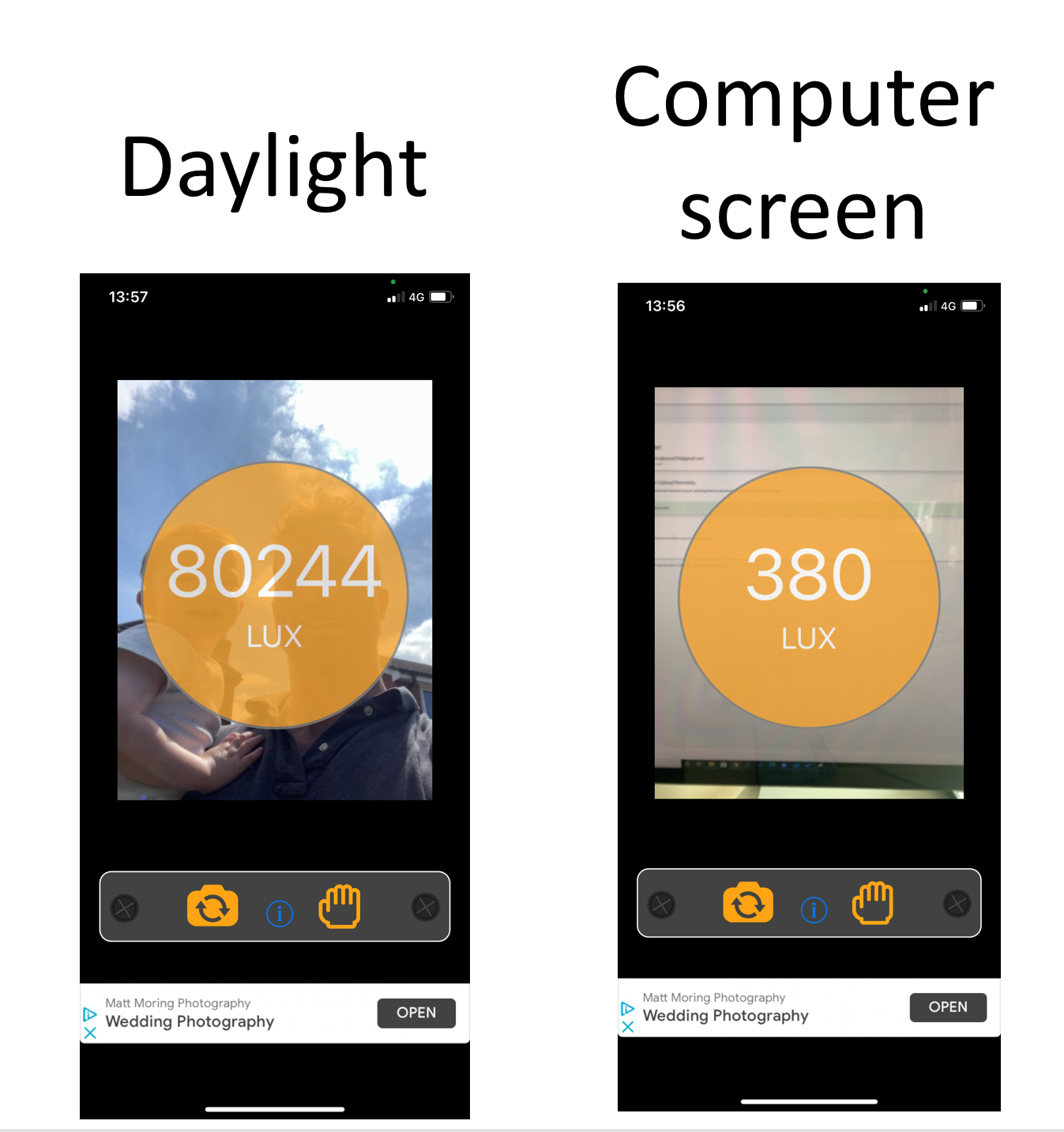
It should come as no surprise that we feel tired and unmotivated after a day inside, yet we cannot sleep!
What about the weekends? Can I not go to bed later?
The last time I looked, the sun did not rise and fall two hours later on a Friday and Saturday night?
The weekend is a human construct designed for socialisation and spending a lot of money. I know this very well as I estimate I spent close to £150,000 loving partying aged 15-35 (a future ‘Partying with type 1 diabetes’ guide to come).
Every Friday and Saturday night, I went to bed at least 3-4 hours later than usual, which threw my circadian rhythm out of whack! I was tired, grumpy, and unproductive every Monday, Tuesday, and sometimes Wednesday. I always recovered by Thursday, just in time to do it all again.
This is what happens to teenagers by staying up for a Netflix marathon or online gaming fest! Is there any wonder they are so hard to get out of bed for school on Monday, Tuesday, and maybe Wednesday morning?
This phenomenon is called social jetlag.
Top tips:
- Start the day with 15-30 mins outside in the natural light. Grace and Jude the video below is our morning energy dance.
- Schedule in 15 mins outside breaks in the natural lights mid-morning, lunch-time and the afternoon – just as they do at school.
- Dim the lights, lamps, or candlelight at least one hour before bed.
- All phones, computers, and gadgets off at least one hour before bed.
- No electronic devices in bedrooms!
- Never more than one hour later to bed on the weekends – it took me to age 35 to get this right!
Why off devices at least one hour before bed?
A study assessing 1732 young American adults found using social media regularly within 30 minutes of sleep time reported much higher levels of sleep disturbance.
Ok, no social media within 30 minutes of bed, but I can use as much as I like throughout the day?
Not quite.
Two hours of digital engagement seems to be the magic number. This study assessed over 120,000 adolescents’ usage of computers, SMART phones, TV, and movies. The findings showed that when used past two hours per day, mental well-being starts to drop. There is a more aggressive drop in mental health when Smart phone usage goes beyond two hours which can be seen on graph d.
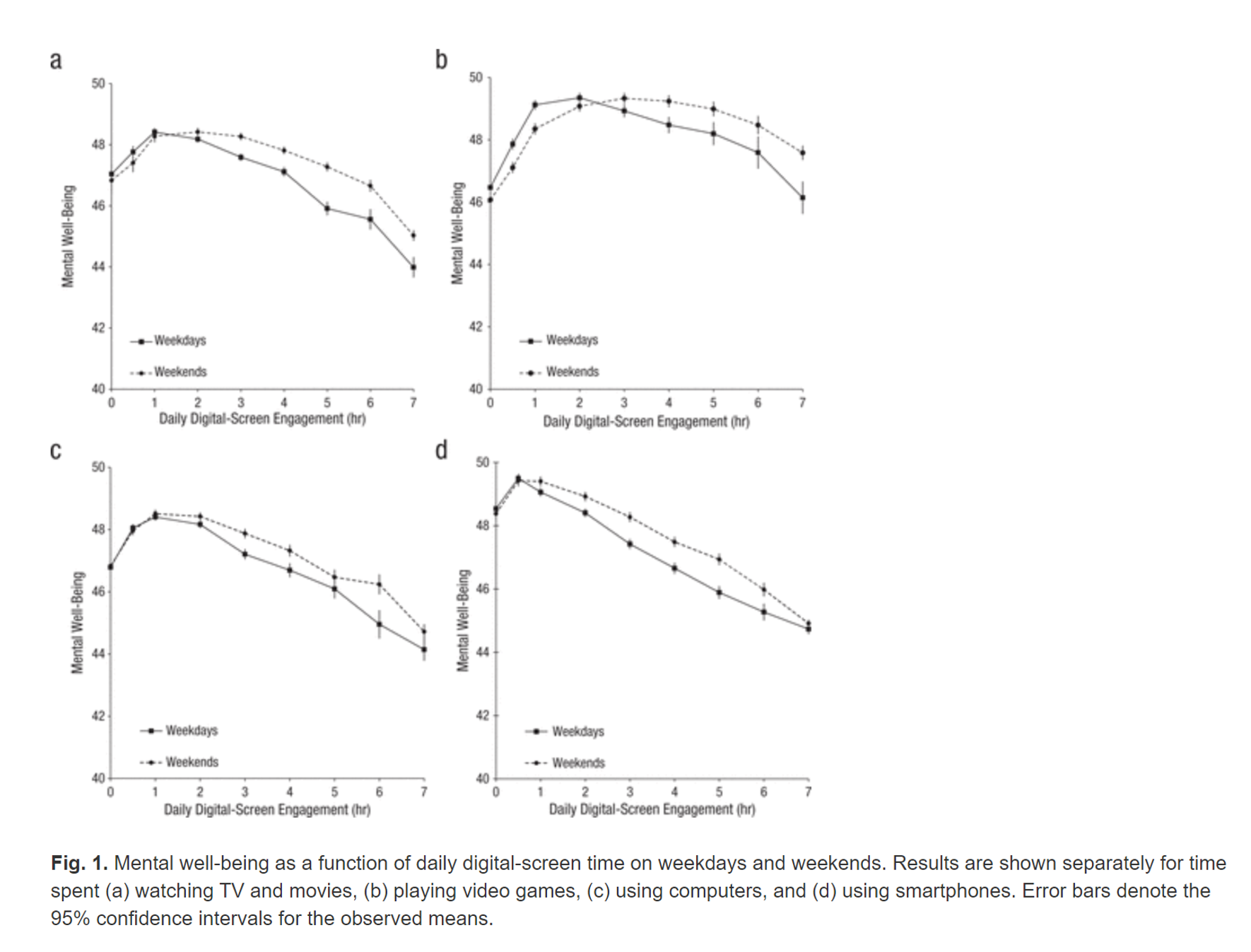
So two hours should be the limit, but does the type of social media matter?
This national survey suggests it does.
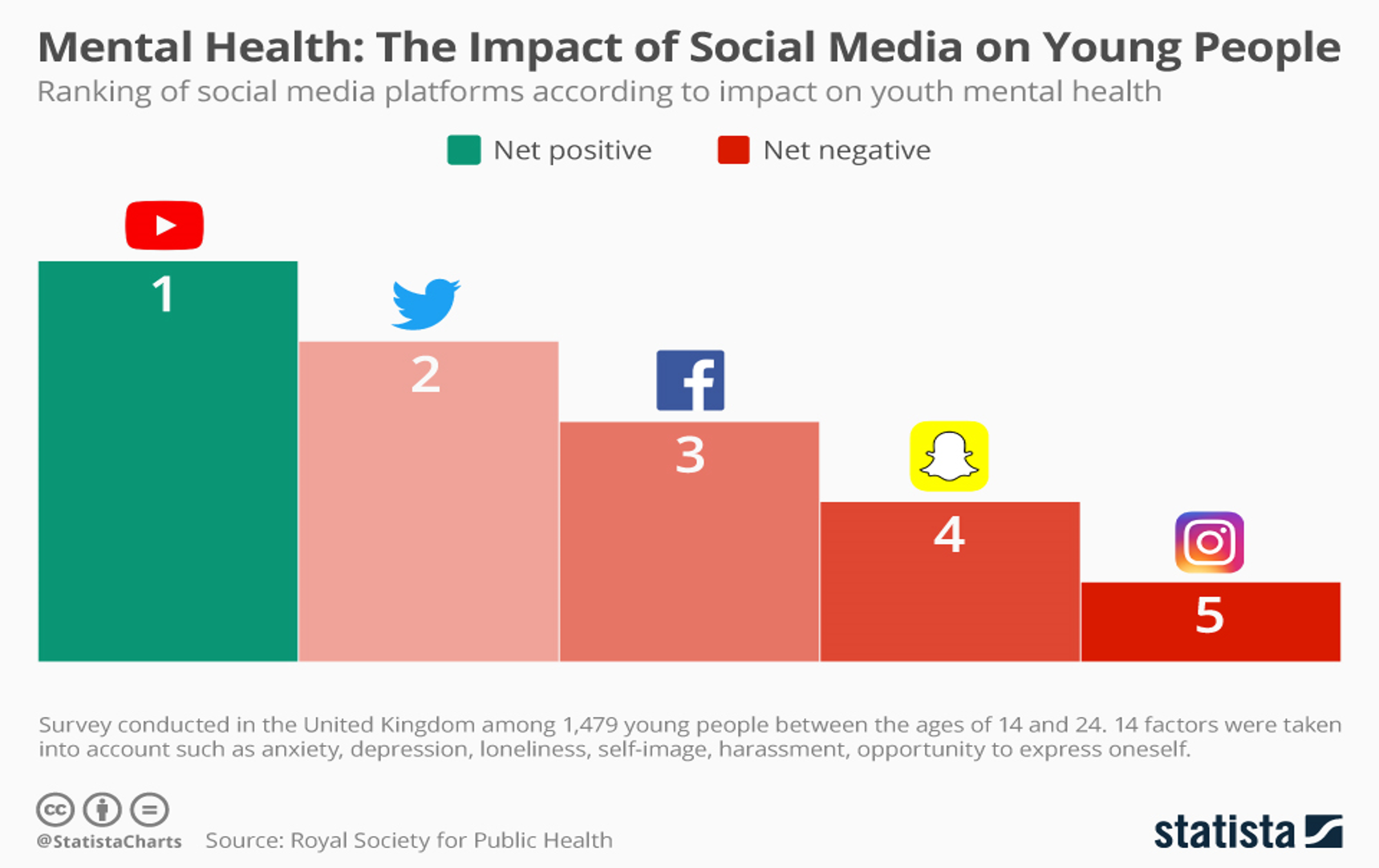
The platforms using picture-based profiles that allow direct comparison to peoples BEST SELF is when the mental health takes a turn for the worse. It can foster a mindset of “I am not good enough” when you are constantly comparing your life to the highlight reel of other people’s lives!
I consider myself to be on pretty good physical shape, and probably in the top five percent of the population for my age. However, when I used to use Facebook and Instagram do you think that mattered?
Hell no! I spent my time looking at profiles of those in the top one percent. Unknowingly fostering a mindset of “I am not good enough”.
Solution?
I fully deleted my Facebook and Instagram accounts in 2018. It’s been the biggest mental heath upgrade I have ever had. As a side bonus, I actually spend an extra two hours a day paying proper attention to my wife and kids! Instead of being a phone zombie stalking profiles or watching cat videos!
Grace and Jude, here will be your allowance:
- Maximum daily screen time two hours.
- No social media with a picture-based profile (Facebook, Instagram, Snapchat etc.).
- Phones and devices off one hour before bed.
Caffeine
As a staunch caffeine addict, this was sobering but important to write.
Caffeine promotes alertness by blocking another sleep-promoting brain chemical called adenosine.
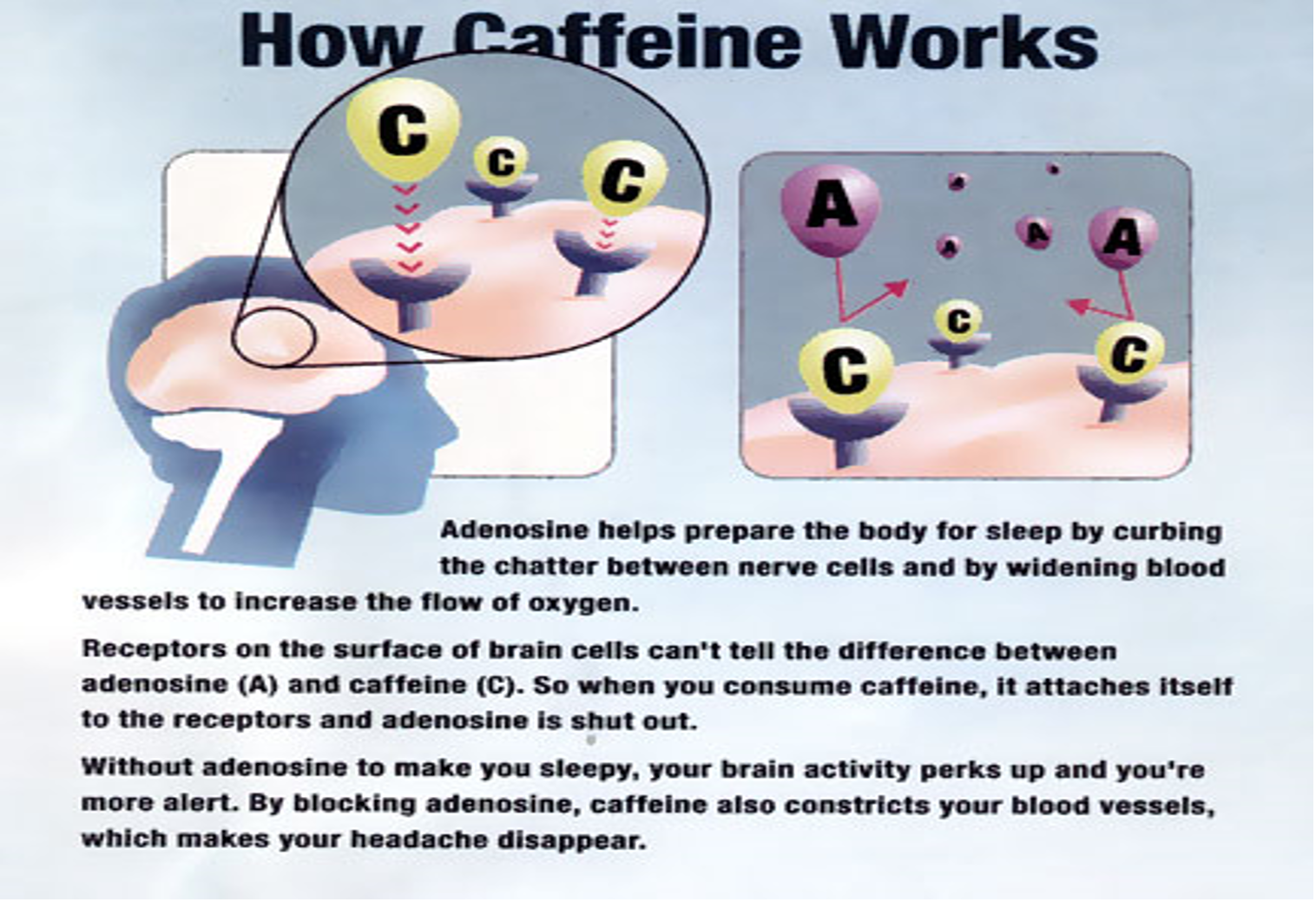
Every time you consume caffeine, the sleepiness from adenosine is prevented. This can be useful when you need to be more alert but can become an issue with overuse as the number of adenosine receptors increase. This means you need to increase your caffeine intake to get the same effect. This is known as dependence or the drugs trap!
A poor night’s sleep, feel tired, use caffeine with good effect, keep smashing it every day until dependent – I am 100% guilty of this, as you know, Dani.
Or
You try caffeine, get a lot of work done, and keep doing it, but the effect wears off. You progressively increase your intake to dependence.
As with any drug, the dose makes the poison!
Caffeine hangs around in the body for 8-12 hrs and can cause sleep disturbances if consumed after midday.
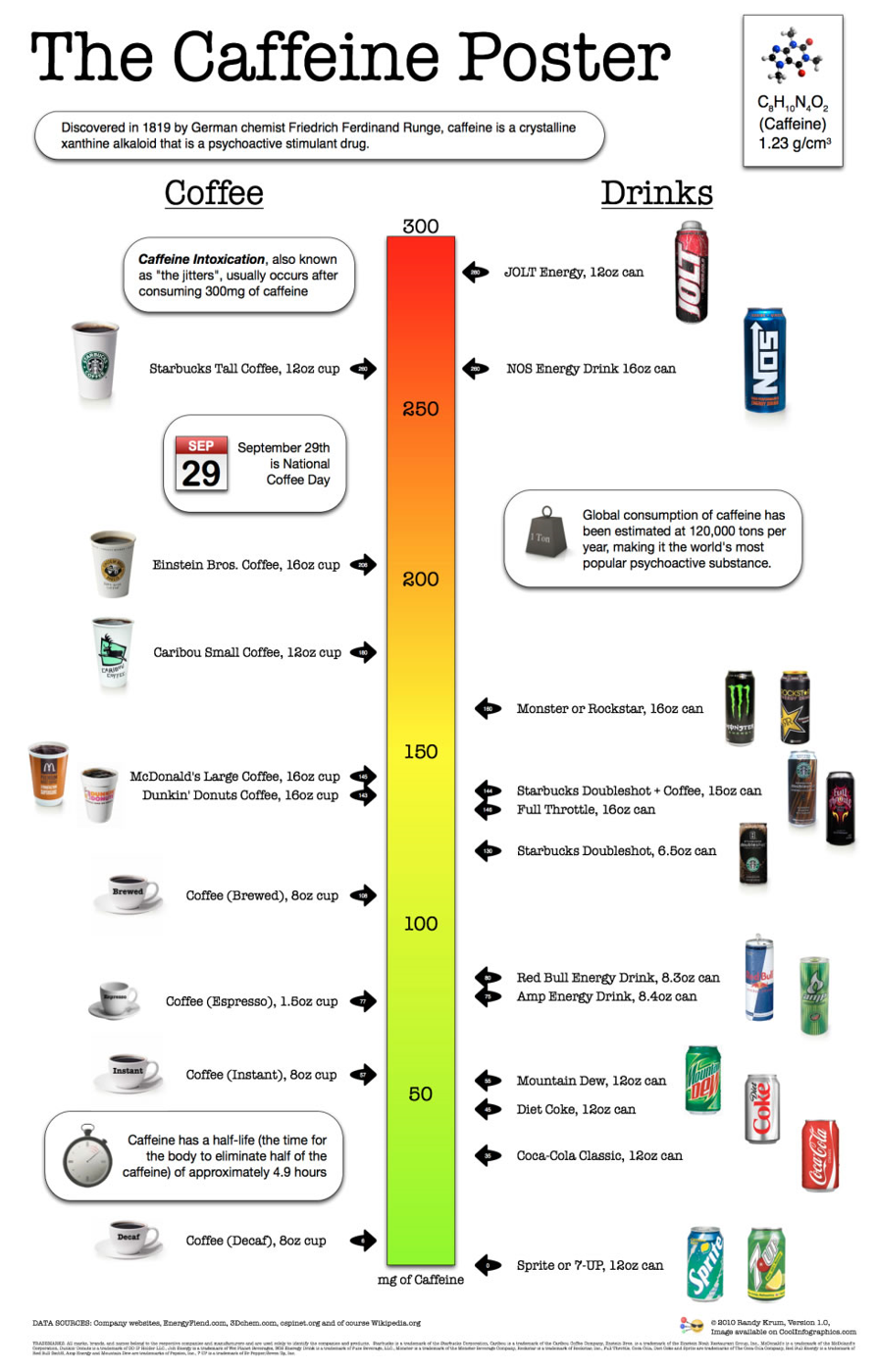
The safe limit for adults is 200-400mg per day, which is easy to surpass, especially if you are fond of the coffee house.
More worryingly, if your children have “Energy drinks” every day, they are in danger of becoming severe addicts.
Did you ever wonder why kids like coke more than lemonade when they both have the same amount of sugar?
Ever said, “It’s the sugar in this coke that sends my kid off the wall!”
Is it the sugar or the buzz they get from 35mg of caffeine per can of coke?
Could they be being set up for a life of addiction to their favourite caffeinated brand that gives them so much initial positive reinforcement?
Here are some thoughts:
- Anyone aged under 18 years old should avoid caffeine as their sleep routine should mean they do not need it. If they are having coffee, coke, or energy drinks every day – you have a future addict on your hands.
- For adults, the last caffeinated beverage should be consumed no later than 12:00 to allow blood levels to drop low enough for restful sleep. Do not go over 400mg a day consistently.
- If you are a full-blown addict, this is a great resource. I have had to use it on more than one occasion to reset my adenosine receptors. I will no doubt have to use it again.
Again, monkey sees, monkey does – You must walk the talk and keep a close eye on your own and your children’s caffeine intake.
Eating routine
The school days are structured nicely to limit access to food. Therefore, it is pretty easy to get a good eating structure. During holidays the routine goes out of the window. The snack cupboard is open all hours, and the structure descends into chaos.
Can you guess which one is school and holidays?
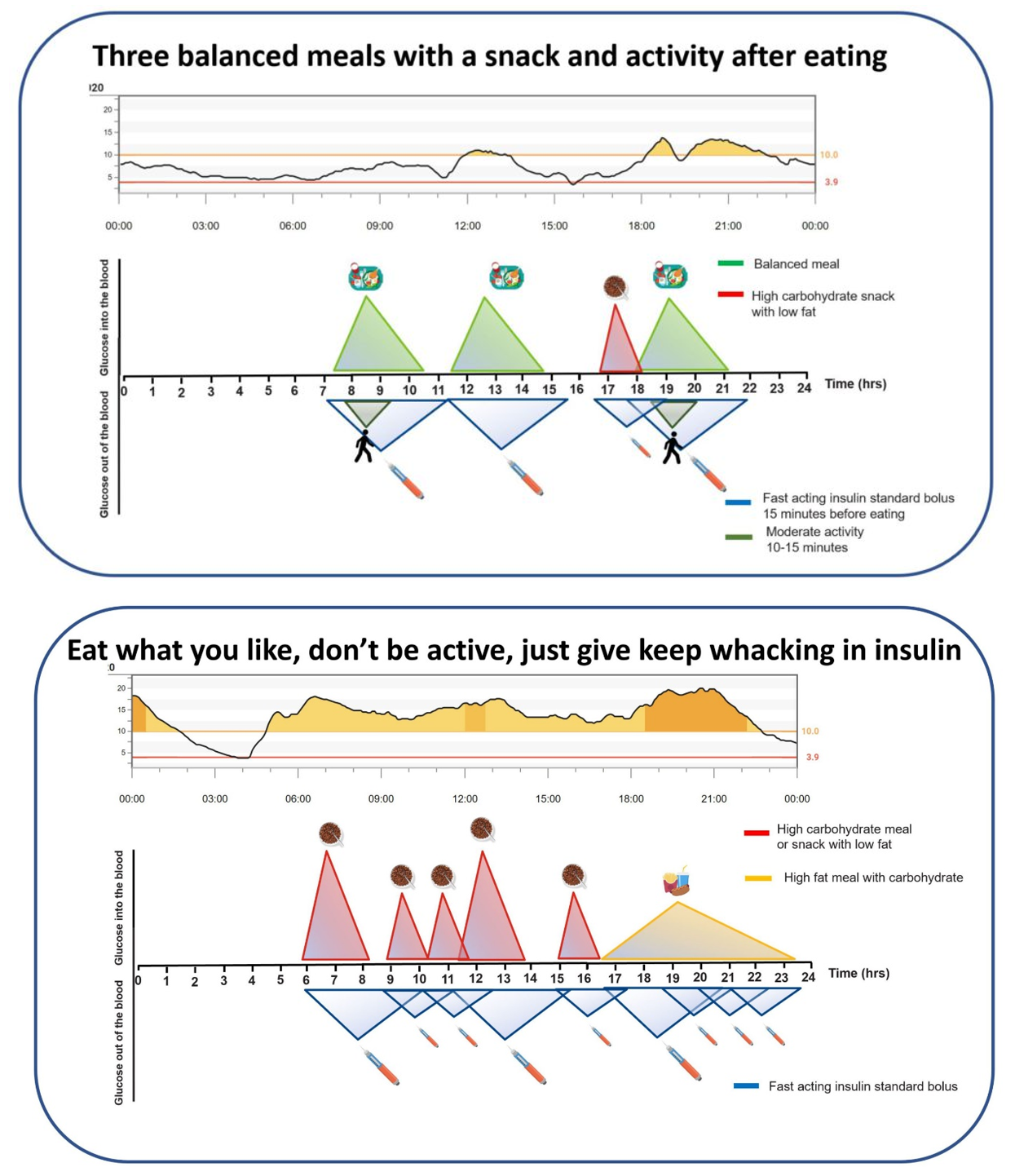
The key is creating a daily structure that mimics the school day. Here are the top tips:
- All snacks out of sight and minimal supplies in the house.
- Make healthy meals such as soups that can be frozen and reheated quickly.
- Play outside, away from the kitchen.
But what about snacks and supper? My children NEED them?
There is no need for multiple snacks and supper for children aged six years and over! This is a myth.
Suppers may have been needed with older insulins that caused hypos overnight. Now we have long-acting stable analogues such as Lantus, Levemir, Tresiba, and basal insulin from pumps – this is rarely an issue – So ditch the old thinking!
By having the last meal three hours before bed, 5-6pm, the food will have been digested and bolus insulin mainly finished, therefore:
- If basal insulin is set right, the glucose level should stay steady ish overnight.
- There will be no food in the digestive system leading to highs.
- There will be no excess bolus insulin system in the system, causing lows.
- The digestive tract will then be empty for at least 8 hours overnight, which is needed so the liver, kidney, and digestive system and repair instead of metabolising!
What about before-meal insulin timing during the holidays?
As a minimum, give mealtime insulin 15 minutes before meals.
If you want excellent control, use SET from Dynamic Glucose Management.
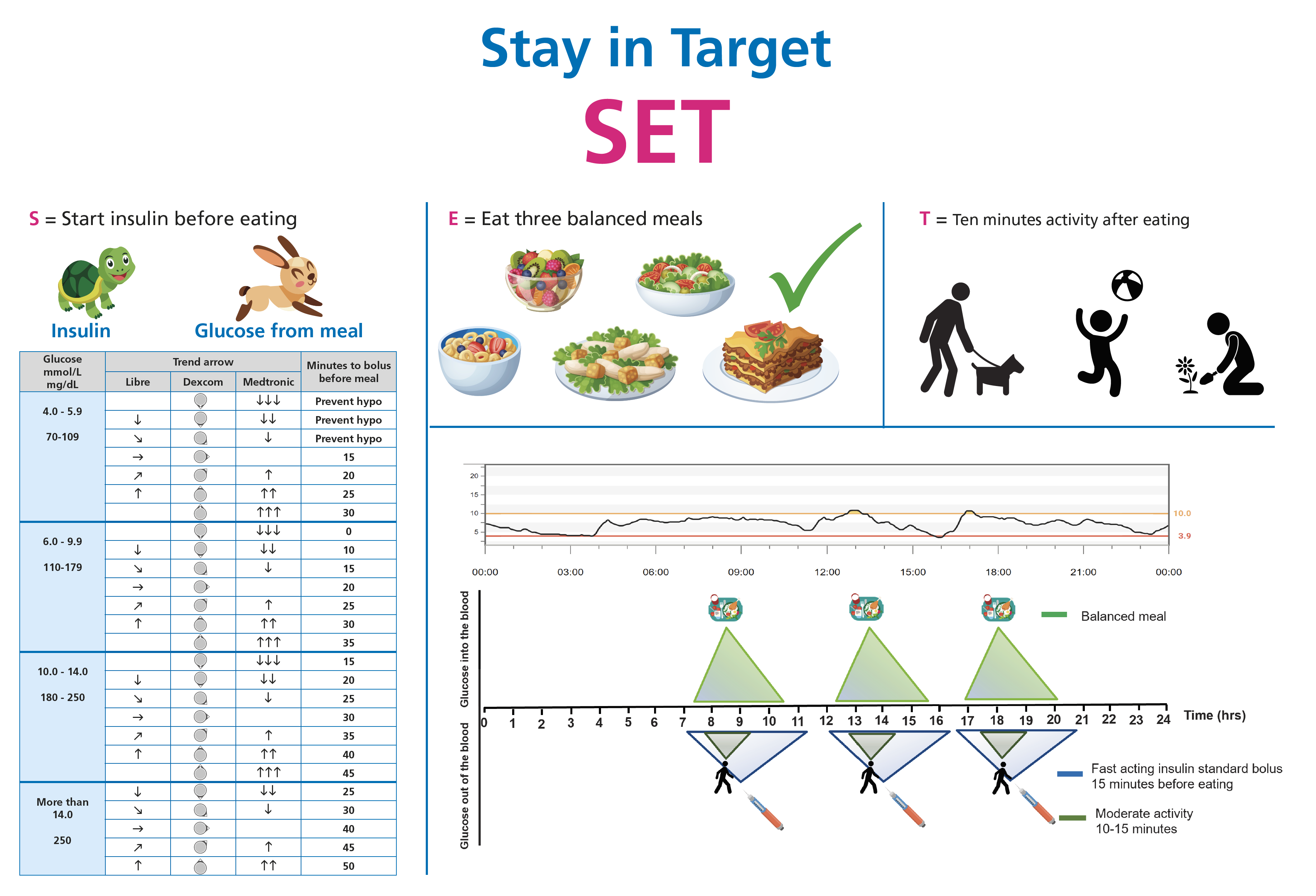
What about the change in routine and eating out?
Follow the Mealtime Insulin Guide.
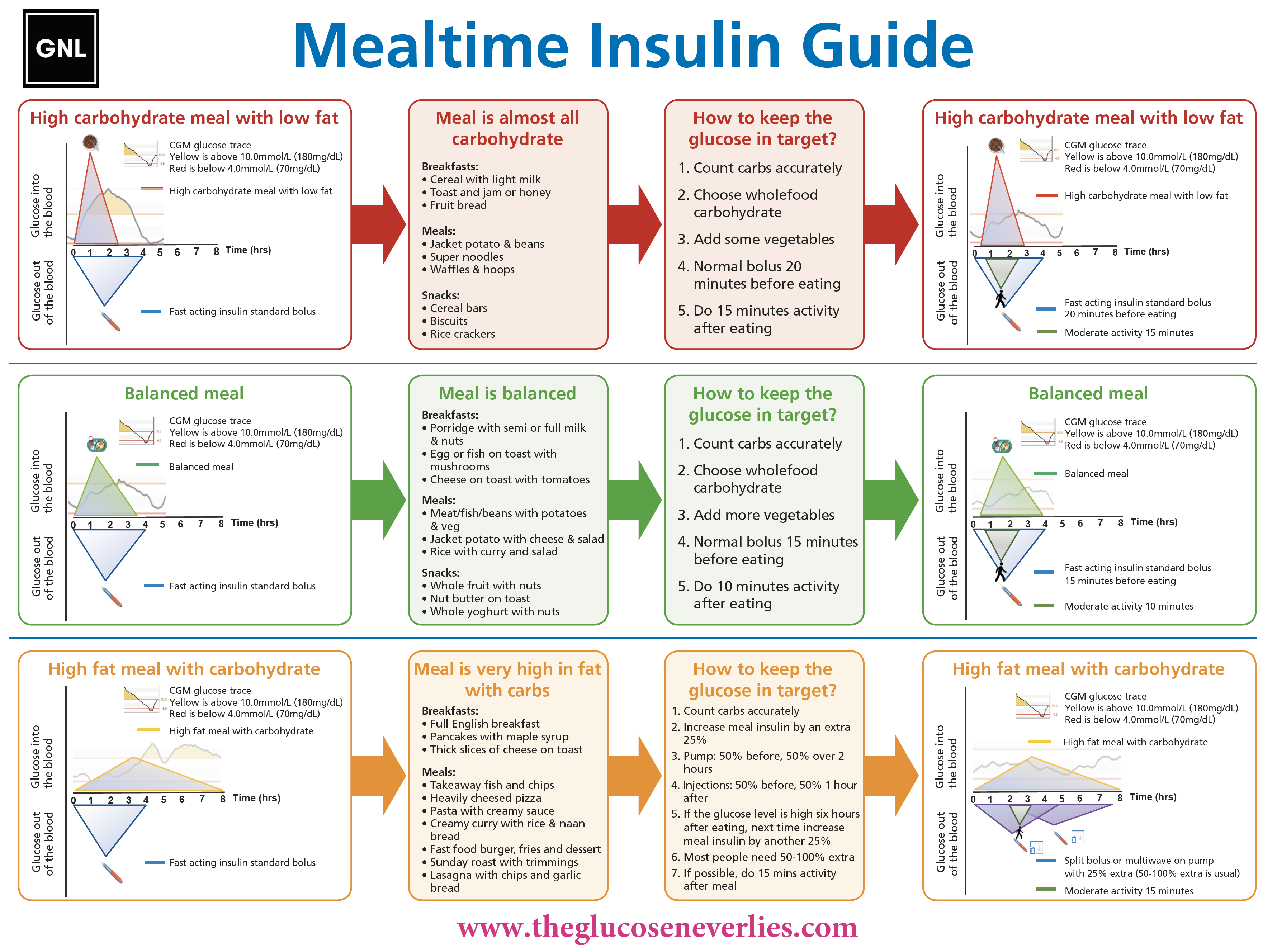
Moving routine
The school day provides lots of opportunities to move.
- Walking to school.
- Playtime at 10:00.
- Playtime after lunch.
- Walk home from school.
The required hour of moderate activity a day is not an issue.
This structure disappears when the holidays hit and is often replaced by binge-watching of TV or X-box marathons.
A quick recap on the power of activity to keep glucose levels under control.
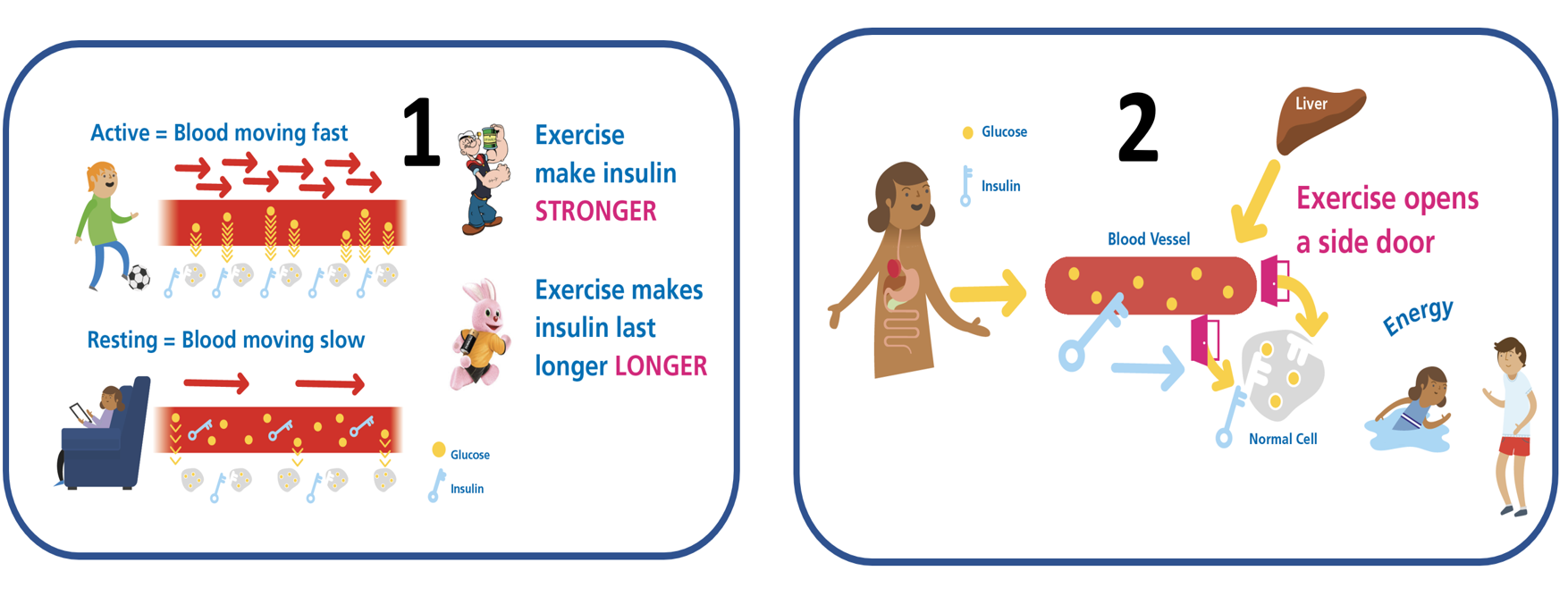
Without movement after eating, the glucose level skyrockets, and often a lot more insulin is needed. Just check out the improvement in glucose profile when 20 minutes of activity is included after a high carb meal such as cereal.
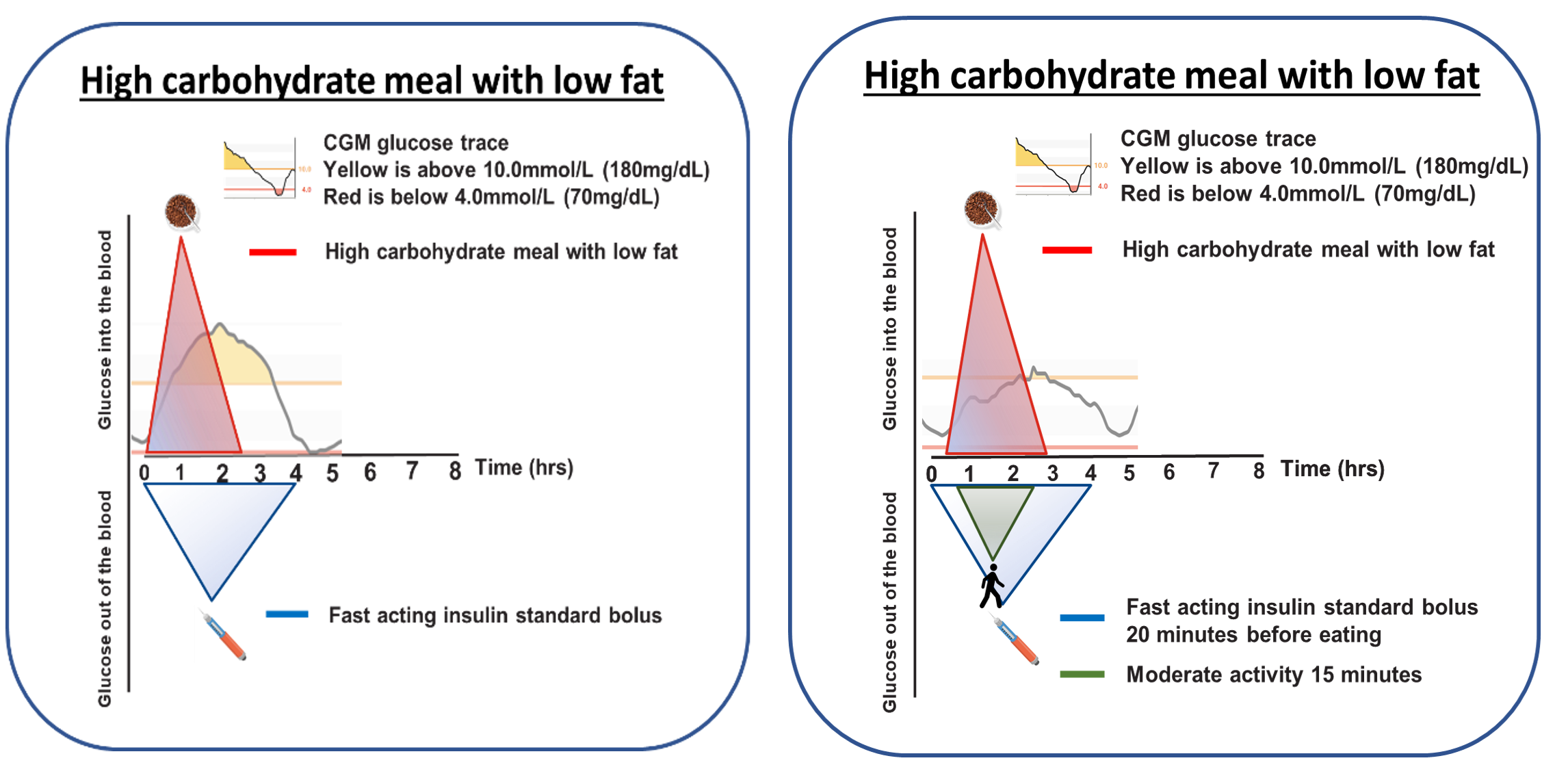
The solution is simple but not so easy to implement. The daily structure needs 10-20 minutes of activity after meals doing fun things. Here are some ideas:
- If you have a dog – problem solved, two walks per day.
- Playing out in the garden.
- Don’t buy milk at the supermarket. Take a daily walk to the shop in the morning.
- YouTube has loads of fun short dances – we do the pink and yellow baby Zumba dance.
- Monkey see, monkey do – As a parent, you have got to walk the talk, and it’s excellent for your health too!
What about exercise, how do you manage that in the holidays?
There is an entire section on the Blog called the Exercise Guide that teaches about how to manage aerobic, mixed and anaerobic exercise with type 1 diabetes.
This table on insulin adjustments will give a reasonable starting point. Still, it will need adaptation using trial and error. Carb suggestions can be found in the exercise section.
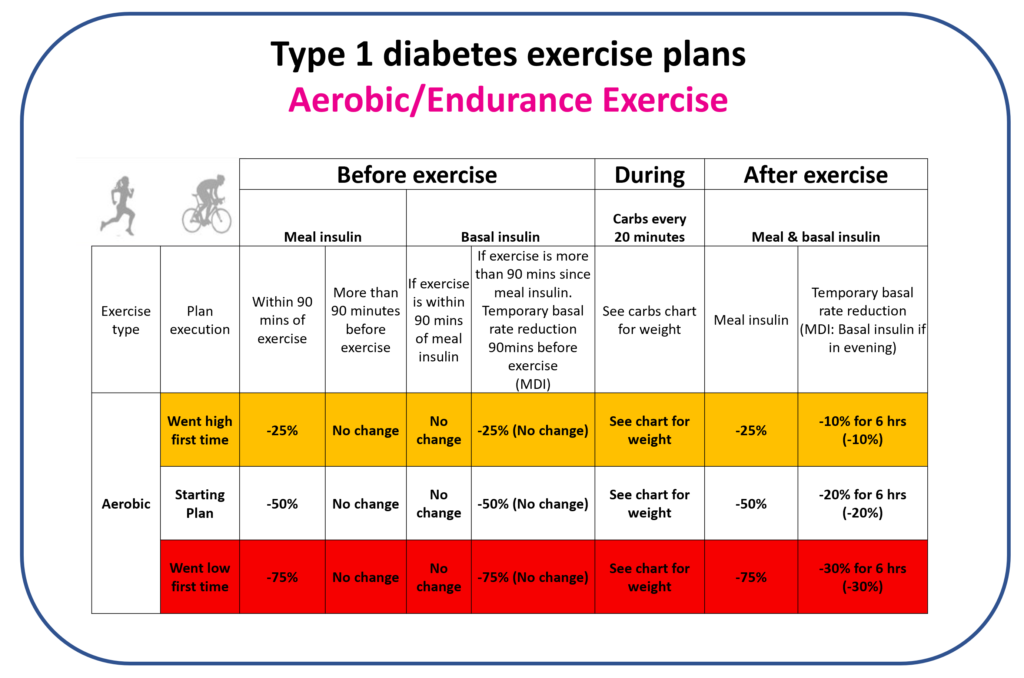
If exercise lowers glucose, could I use it to reduce high levels in-between meals?
Absolutely, this will also mean less insulin is needed, helping keep weight under control and protecting against heart issues in the future.
This is how to do it using GAME from Dynamic Glucose management.
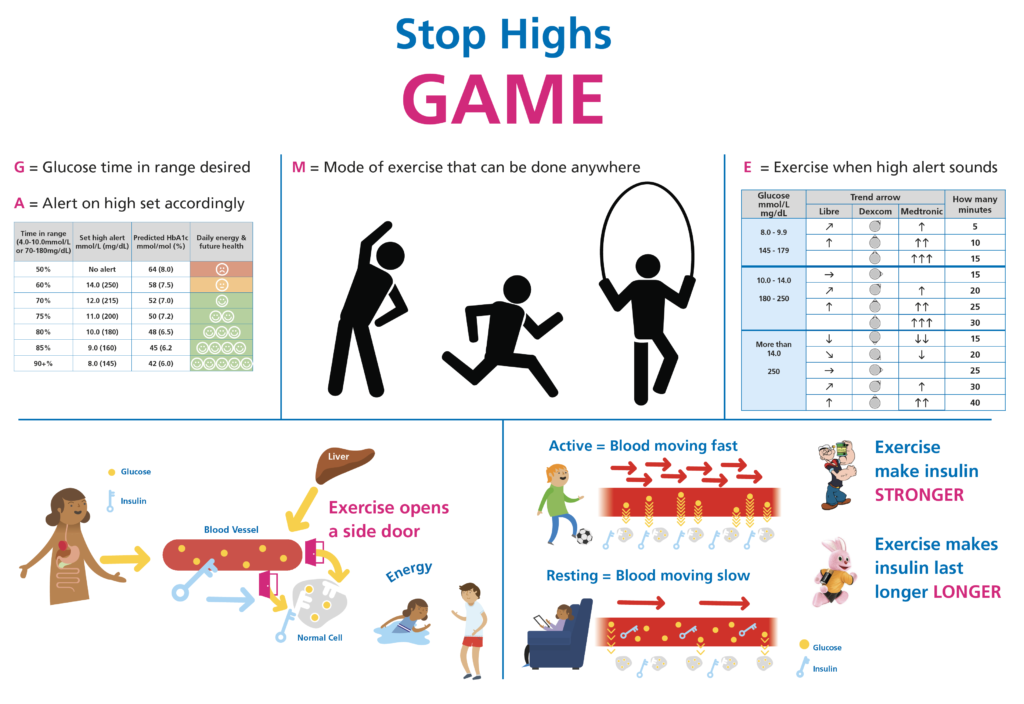
What about hypos with significant changes in activity levels?
When routine changes, there is an increased risk of hypos. Therefore, using MATCH from Dynamic Glucose Management will come in handy.
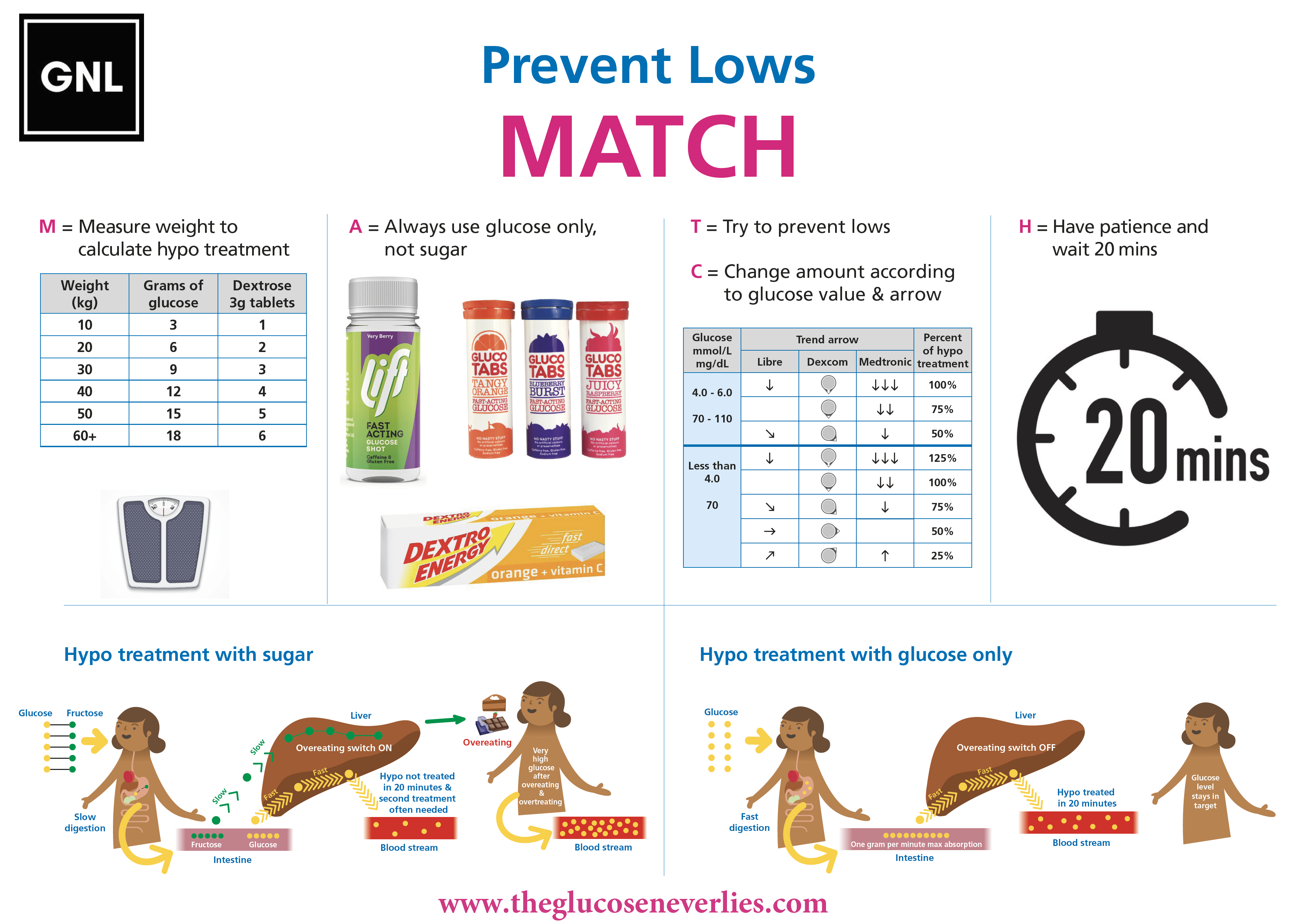
Putting GAME-SET-MATCH together.

Dani, Grace, and Jude will be on holiday for at least 12 of the 52 weeks in the year.
I don’t think it’s good enough for us to say:
“It’s the holidays. Things will get back under control when back at school”.
Let’s definitely do the 80:20 plan and maybe some of the Kitchen Sink?


Love John (Dad)
Do you want to know when a new section of the blog is added, click here?
